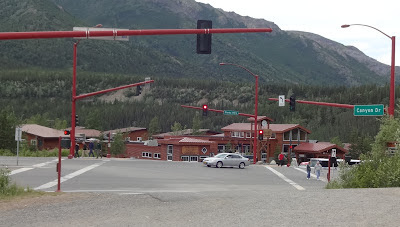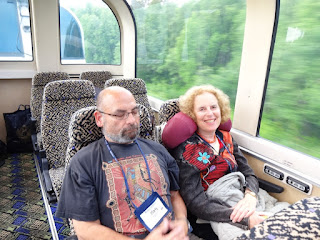We took the train from Anchorage to Denali Park as part of our Holland America cruise/tour. Holland America has 10 of its own domed railroad cars with elevators in
them for handicapped access. Each car has 2 "stories."
 |
| Howard climbing to seating area |
The dining section is below and
the top domed part is for sitting and viewing. The seats aren't the most comfortable, leaning back a bit far. Sometimes I
found better viewing in the dining car and the outside viewing platform. We road by lots of streams, rivers, and lakes, tundra areas and taiga too. The guide gave an excellent narration. She was older and possibly a former teacher.
We had had breakfast before we left the hotel at
7, so didn’t eat it on the train. We
had assigned seating on the Knik car, named for the Knik River at MP 146.
We were in the last seated row on the car and
it made it easy for us to stand a lot and not obstruct other people’s
views.
MP (mile post) zero is at Seward.
Anchorage is at MP 114.3. Denali
National Park at 347.9. So we went from MP 114.3 to MP 347.9. (Fairbanks is at
470.3. ) Passengers travel during the day
in tourist season and items are transported at night to maximize use of the
tracks.
Alaska Railroad Map
As we left town we saw several fighter jets in the air. They were based at Joint Base Elmendorf-Fort
Richardson (JBER) and covers 84,000 acres. Troops that end up in Afghanistan
train here because of the rugged conditions.
A suburb of Anchorage, Eagle River, was ten miles north. We went slower as lots of construction was taking place. Our car had a tourist guide who gave a running narration. Her husband was the bartender. She said that Alaska really has two
seasons: winter and construction.
We saw trees that curved in a big bend. They had been pushed down by the heavy snow,
and then the sap inside froze. After
defrosting, the trees staying in the curved position and are called “drunken”
trees.
We passed by some trees killed by salt water of tsunami and had petrified.
She mentioned that Alaska ha sover 1000 earthquakes a year of 3.5 or greater on Richter
scale.
There are three main kinds of deciduous trees along the way: Aspen, birch and cottonwood, and I am allergic to the first two!
The main evergreen trees in the area are spruce both black which are scrappy looking and half dead looking in the middle and white spruce.
We passed the Knik Arm, the norther arm of cook Inlet. Knik is an Anabaska word for “burn” as
sometimes at sunset, it looks orange.
The area has 40 foot tides. The
basin is filling with ground sediment form large glacial rivers which drain
into it.
Unfortunately, we had an overcast day so we could not see the mountains in the background, and never did see Mt. McKinley (Denali). Here is a picture postcard view of it--I took a picture of the postcard for sale on the train!
MP 148.3 Is the Matanuska
River and the Mat-Su Valley, where much of
Alaska’s agriculture is grown. The rich
glacial soil plus long days of sunlight (up to 19 hr) in the short 90 day growing season leads to
monster sized produce: Record cantaloupe
= 64 lb and record carrot = 19 lb. and cabbages
over 80 lb.
In
1935 New Deal brought 200 farming families from the Midwest to farm here and some still remain. The most reliable plants to grow are lettuce,
potatoes, carrots, cabbages, peas, and beets. Moose like vegetables and particularly favor cabbage, broccoli, peas, and beet tops, so
gardens must have high fences around their crops!
 |
| Wasilla Lake |
MP 159.6 The town of Wasilla was
named for Chief Wasilla, an Athabascan Indian.
It as founded in 1917 as a supply center. We passed by Wasilla Lake (right side of train) in town where Sarah Palin had her home when she was mayor and later Lake Lucille (left side of train) where Palin lives now. The town is long from urban sprawl.
 |
| Wasilla Urban Sprawl |
It has had a huge increase in population (and is over 8,000 people now) as home prices are 25% less than in Anchorage, so people commute from Wasilla to Anchorage. The Iditarod used to start in this town but it is now too populated so since 2008 the race starts a bit farther north in a town of only 800.
At MP 163 we saw an osprey nest. There were 2 adults, one nearby and one in the nest with the baby.
 |
| Osprey top left and osprey nest on right |
By MP 180, we saw part of the Nancy Lake
Recreation Area with 36 sq miles and more than 100 lakes. Some people canoe/boat on one and then take a
short trail to another, carrying their canoes. Many of the smaller lakes in Alaska are not named.
We had a nice lunch on the train.
The men had reindeer stew served in a bread bowl. Marsha and I had butternut squash soup with a
hint of curry and little tiny pieces of vegetables in it.
Up to
here, most of the scenery was on the left with steep hills on the right so again Marsha and Marty had the better seats (assigned) :). After lunch, there was more to see on the
right also.
MP 226.7
Talkeetna is a little "frontier" town of 900 people with the "flavor" of Alaska's past. It is the town that the TV show Northern Exposure was
based on but it was too cold for the actors so they moved to Washington State to continue filing! President Harding stayed
at this town’s White Fairview Inn when he came to Alaska to drive the golden
spike into the RR in 1923. It was
originally an Indian village but settled by prospectors and trappers in the
early 1900s. At first there were 10 men
per woman, but now the ratio is closer to 3 to 1. Joke
heard many times: Why are there still
single women in Alaska: The odds are
good for women finding spouses but some of the goods are odd. There was a trailer park just a bit past the station with summer visitors.
 |
| Talkeetna Train Station |
Just north of that town are lush fields full of fiddlehead ferns. Then the scenery tapers off to give way to a narrow corridor of dense forest.
At MP 269.2, we saw beaver dams in the river beside the train, but the train was going to fast to take a decent picture.
We saw several "dry" cabins along the way, dry because they had no electricity, heat, or water. We were told that there are an amazing number of these isolated cabins, often with lots of firewood stacked up beside them.
 |
| Orange speck is a "dry" cabin |
We passed over a bridge over Hurricane Gulch. The bridge, built in 1921, spans 918 feet and is a296 feet above the Chulitna River. . Winds can be as high as 150 MPH The Alaska RR runs two stress tests daily on the
bridge. Howard did not look out the window!
 |
| See drop off from train |
 |
| View of Hurricane Gulch from Train |
 |
| Our Train About to Go Over Bridge |
We were going fairly high and went over Broad Pass, the highest point on the Alaska Railroad at 2,363 feet, before we arrived at Denali Park. It was definitely colder there, in part due to the elevation and also from the surrounding mountains. We got to the train station just before 4 p.m. and got a bus to our motel. All the motels are outside of the park except for the few in the north end of the park that got grandfathered in when the park tripled in size during the Carter administration.
The scenery along the route was gorgeous but the train was going too fast for me to take pictures of the wildlife that we saw, and often we only saw them for an instant. The engineers would advise the guides of a sighting and then we would all look, successful about half of the time!
After a ten-minute bus ride, we arrived at our hotel, across the street from a stop light! It wasn't a very populated area, but the "hotel area downtown" with shops and restaurants was across the street.
 |
| Our Hotel and stop light |
 |
| Walking toward our room |
 |
| Path |
 |
| Shrubby Cinquefoil |
 |
| Growing out of a rocky area |
 | |
| Siberian Aster |
 | ||
| probably a "misfit" rock |
 |
| Eskimo Potato |
The Eskimo potato, a member of the pea family, produces edible tuberous roots that the bears love. This is the most nutritious indigenous plant in Alaska. The flowers come out in late June through July and then the plant produces a seed pod which is thought to be poisonous. Some Alaskan natives will mash up the plant root and use it as butter. The plant grows up to two or 2.5 feet high. This one was under a foot tall.
 |
| Old Man's Beard growing on limbs |
Old Man's Beard is a hair-like lichen that grows on spruce trees in Alaska. They are light green to black in color. Natives use it as a last food resort by boiling it.
 |
| Sitka Rose |
We went across the street to explore and ended up at the recommended place, the Salmon House, for dinner. it was at the end of the shopping area. BTW, shopping did NOT include a good place for snacks to take on the bus ride in the park. We should have stocked up at Safeway in the Seward area.
We were surprised to see a baby gull in the parking lot as we walked along.
The Salmon House was good--thick salmon cooked the way it should be--moist and a bit red in the center.
The flor tilted a bit downward (probably because of the many earthquakes a year) and Marsha kept on sliding down her chair. She experimenting with using one of her "layers" to tie herself to the chair.
 |
| Interesting small item for sale in hotel gift shop |
Good informative placemat at the restaurant:
We were not provided with breakfast on this part of the tour, so I walked up to Subway the two mornings and got myself and egg white 6" breakfast sandwich for about $5 or $6. Full sized sandwiches were $9.
Many of the young workers in the shops for the summer (when they are open) are from Bulgaria. I also met an Indian from Ecuador and talked to him for a while. It was an interesting crowd and a great way for them to pass the summer.
























No comments:
Post a Comment